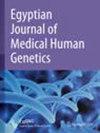System biology approach to delineate expressional difference in the blood mononuclear cells between healthy and Turner syndrome individuals
IF 1.1
Q4 GENETICS & HEREDITY
引用次数: 0
Abstract
Turner syndrome (TS) is a rare disorder associated either with complete or partial loss of one X chromosome in women. The information on the genotype–phenotype relationship in TS is inadequate. Comparing the healthy and Turner syndrome patients may help elucidate the mechanisms involved in TS pathophysiology. Gene expression differences between healthy and individuals with Turner syndrome were characterized using the systems-biology approach of weighted gene coexpression network analysis (WGCNA) on 182 microarray peripheral mononuclear blood samples (PBMC). The coexpression networks of healthy and TS had scale-free topology that ensures network robustness. In the process, five modules were preserved between healthy and TS, which carry several genes common in each module. Two of them, SMCHD1 and PGK1, have already been reported to be involved in TS. Previously reported genes of TS, specifically, PTPN22, RPS4X, CSF2RA, and TIMP1, were missing in their respective modules. Dysfunction, differential expression, or absence of these genes could lead to a progressive disruption of molecular pathways leading to the pathophysiology of TS. Indeed, we observed a significant difference in the functions of these modules when compared within and across the healthy and TS samples. We identified four clusters in the PPI network constructed from the top 15 KME enriched in significant functions. Overall, our work highlights the potential molecular functions, pathways, and molecular targets of TS that can be exploited therapeutically in the human healthcare system.用系统生物学方法确定健康人和特纳综合征患者血液单核细胞的表达差异
特纳综合征(Turner syndrome,TS)是一种罕见的疾病,与女性完全或部分缺失一条 X 染色体有关。有关 TS 基因型与表型关系的信息尚不充分。对健康人和特纳综合征患者进行比较可能有助于阐明特纳综合征的病理生理学机制。研究人员采用系统生物学的加权基因共表达网络分析(WGCNA)方法,对182个微阵列外周单核血样本(PBMC)进行了研究,以确定健康人和特纳综合征患者之间的基因表达差异。健康人和特发性红细胞增多症患者的共表达网络具有无标度拓扑结构,确保了网络的稳健性。在这一过程中,健康人和 TS 之间保留了五个模块,每个模块中都有几个共同的基因。其中,SMCHD1 和 PGK1 这两个基因已被报道与 TS 有关。之前报道的 TS 基因,特别是 PTPN22、RPS4X、CSF2RA 和 TIMP1,在各自的模块中缺失。这些基因的功能障碍、差异表达或缺失可能会导致分子通路逐渐中断,从而导致 TS 的病理生理学。事实上,我们观察到这些模块的功能在健康样本和 TS 样本内部和之间存在显著差异。我们在由具有重要功能的前 15 个 KME 构建的 PPI 网络中发现了四个集群。总之,我们的工作强调了TS的潜在分子功能、通路和分子靶点,这些功能、通路和靶点可在人类医疗保健系统中加以利用。
本文章由计算机程序翻译,如有差异,请以英文原文为准。
求助全文
约1分钟内获得全文
求助全文
来源期刊

Egyptian Journal of Medical Human Genetics
Medicine-Genetics (clinical)
CiteScore
2.20
自引率
7.70%
发文量
150
审稿时长
18 weeks
 求助内容:
求助内容: 应助结果提醒方式:
应助结果提醒方式:


